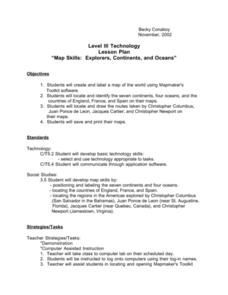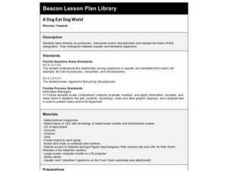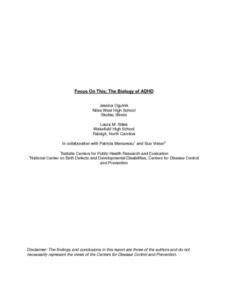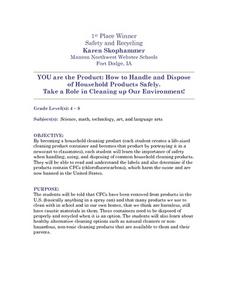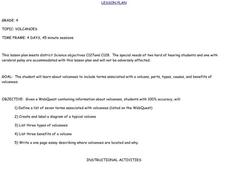Curated OER
Software Lesson On Timeliner 5.0
Fourth graders identify and list 10 significant dates and events in the life of the person that he/she has read about. Using the 10 events identified from the students' chosen biography, they create a timeline using the TimeLiner 5.0...
Curated OER
Communicating With My World - Day Three: Internet
Students, who are studying ESL, examine the use of web sites. In this web site instructional activity, students watch a teacher demonstration of different types of web sites. They discuss how much time people spend on the Internet. They...
Curated OER
Assessing the Labour Behind the Label
Twelfth graders examine the labor conditions in different companies and corporations. In groups, they use the internet to locate the conditions of the companies of the clothes they are wearing. They share their information with the...
Curated OER
Exploring Plants
Students examine plants using adiotapes, Internet research, and print media. They name the plant parts and discover their functions. Students create computer-generated pictures of their plants and label the parts. Other activities...
Curated OER
Map Skills: Explorers, Continents, and Oceans
Third graders use a software program to make and label a map of the world. On the map, they locate the seven continents, oceans and the countries of Europe. They also draw the routes of Christopher Columbus, Juan Ponce de Leon and...
Curated OER
The Oceans Below
Young scholars investigate the geological characteristics of the ocean environment and create a labeled drawing of the ocean floor's geography. Students view videos and conduct Internet research about the ocean's floor and then create...
Curated OER
Life Cycles
Students explore the parts of a flower and pollination of flowers. In this plants lesson, students use an interactive whiteboard to label the parts of a plant and the functions of each part. Students complete a worksheet as an assessment.
Curated OER
Understanding Statistics
In this statistics worksheet, students examine and interpret pictographs and line graphs. Students analyze the provided data in order to create bar graphs, circle graphs, and box and whisker plots. The nine page worksheet accompanies a...
Curated OER
What's My Nutrition Value?
Second graders, in groups, explore how to read labels on food packages. They learn the nutritional value of food.
Curated OER
Venn Diagram
Young scholars classify items and numbers by using a Venn diagram. In this Venn diagram lesson plan, students use the computer to do this and classify pictures and numbers.
Curated OER
Fair Game?
Students evaluate possible gender stereotypes perpetuated by computer games, particularly those designed for girls. They design a prototype for a gender bias-free computer game that would appeal to both males and females.
Curated OER
The Earth is Tilted, What Does that Mean?
Students examine the tilt in the Earth's revolution around the sun. Using that information, they draw a picture and label the indirect and direct rays of the sun. In groups, they answer discussion questions and complete an assessment...
Curated OER
Fractions: Mud Pie Math
Second graders identify and name fractional parts through the use of mud pie manipulatives. In this fractional manipulatives lesson, 2nd graders identify and label halves, thirds, fourths, sixths, eighths, and tenths and order them...
Curated OER
SAS Similarity Theorem
Learners identify and use the similarity theorem. In this geometry lesson, students differentiate between congruent and similar triangles. They solve problems using the computer modifying shapes by dragging.
Curated OER
A Dog Eat Dog World
Fourth graders distinguish between acquatic and terrestrial organisms. They label animals as producers, consumers, and/or decomposers.
Curated OER
Plotting the Ocean Floor
Fourth graders plot points on a graph, connect the dots to make the ocean floor profile and label the topographical features. They utilize a worksheet and a website imbedded in this plan to plot the ocean floor.
Curated OER
The Biology of ADHD
Students investigate the biology of ADHD and its implications upon the formation and treatment of the disease. They draw and label the parts of a neuron. Also, they describe the neurotransmission cycle. Students create a list of pros and...
Curated OER
Zones of the Rocky Intertidal Zones
Sixth graders predict intertidal zones for organisms. In this intertidal zones lesson, 6th graders analyze an illustration of an organism and a class diagram of the intertidal zones. Students research to locate the zone the organism is...
Curated OER
How to Handle and Dispose of Household Products Safely
Pupils engage in the study of household cleaning products, how to read the labels and how to use them safely and also how to properly dispose of the containers when they are empty. They read the labels and determine if the products...
Curated OER
Areas of Polygons
Students calculate the are of regular polygons. In this geometry activity, students create polygons on the computer and move it around to create different shapes. They explore the area of different polygons and how they inter-relate.
Curated OER
Internet Field Trip on Fractions and Geometry
Students take an Internet field trip to research fractions. ESOL strategies include using pattern block manipulatives and pairing ESOL and non-ESOL students on computers.
Curated OER
Volcanoes
Fourth graders complete a WebQuest about volcanoes. They study vocabulary, label diagrams, list volcano types and benefits. They write an essay telling where volcanoes are located and why.
Curated OER
Plant Parts
Students create a model of the parts of a plant. After reviewing the parts of a plant and their function, students working in groups, construct a plant using various provided materials. Their models are labeled and presented to the...
Curated OER
Name That Continent
Students practice locating the seven continents, four hemispheres, and four oceans using a large world map and a review song. They also import a world map to the Kid Pix computer program then type in proper labels on the map. There are...






